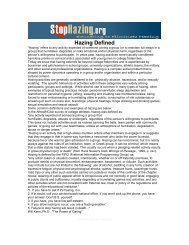Sorority Rituals - Reflections On Rites of ... - Mari Ann Callais
Sorority Rituals - Reflections On Rites of ... - Mari Ann Callais
Sorority Rituals - Reflections On Rites of ... - Mari Ann Callais
You also want an ePaper? Increase the reach of your titles
YUMPU automatically turns print PDFs into web optimized ePapers that Google loves.
ecommendations, the findings were coded by themes and analyzed by the primary researcher<br />
(myself) and are reported in Chapter IV.<br />
In this study, verbatim quotes were used to convey the participants’ thoughts and feelings<br />
to the reader. Merriam (1998) recommends use <strong>of</strong> “rich, thick description . . . providing enough<br />
description so that readers will be able to determine how closely their situations match the<br />
research situation, and hence, whether the findings can be transferred” (p. 211). Lincoln and<br />
Guba (1985) indicate that the construct <strong>of</strong> transferability is the concept that one set <strong>of</strong> findings<br />
may applicable in another study. Lincoln and Guba postulated that determining the transferability<br />
is not the responsibility <strong>of</strong> the original researcher because that researcher cannot determine what<br />
future studies the findings may be applied to. “Therefore, the burden <strong>of</strong> transferability lies with<br />
future researchers” (Williams, 1997, p. 53).<br />
Conformability as proposed by Lincoln and Guba (1985) corresponds with the<br />
quantitative research concept <strong>of</strong> objectivity. Whether or not the data is confirmable is the primary<br />
question according to Lincoln and Guba, not whether or not the researcher is objective. Williams<br />
(1997) states: “Objectivity is not a state which qualitative researchers strive to achieve. By<br />
nature, qualitative research is subjective. All researchers approach the research process with<br />
certain inherent biases” (p. 54). At the beginning <strong>of</strong> my study, I outlined and identified my<br />
experiences and preconceptions as it related to this research and established a system <strong>of</strong> data<br />
analysis that would help me to maintain neutrality in reporting the results.<br />
Pilot Study<br />
The interview structure was guided by questions that address the participant's beliefs and<br />
values and thoughts as to what role ritual has in her individual behavior (See Appendix C).<br />
Questions addressed the participant’s perception <strong>of</strong> the role <strong>of</strong> ritual in her chapter’s behavior as<br />
72



